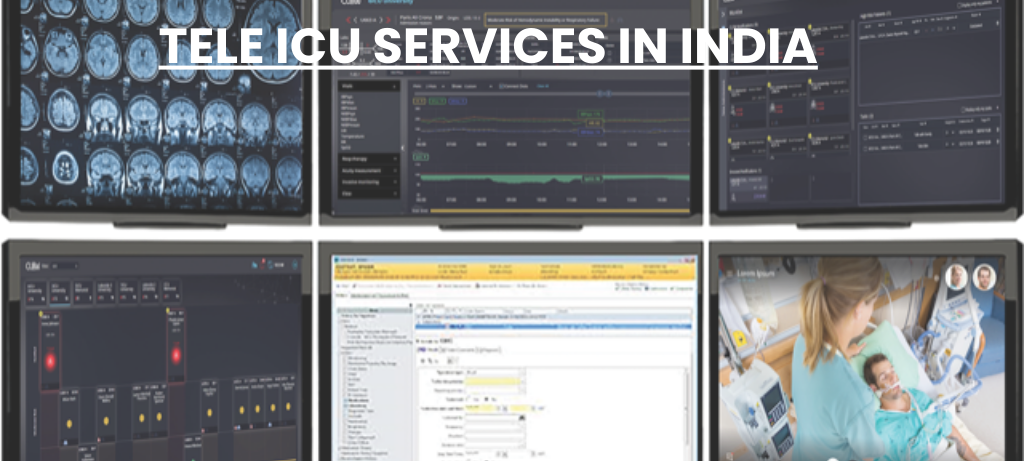The appearance of technology has transformed various sectors, and healthcare is no exception. One of the most significant advancements in recent years is the integration of telemedicine into critical care units, resulting in the emergence of Tele ICU services. In India, where healthcare infrastructure is often stretched thin, Tele ICU services are proving to be a game-changer. This blog explores the evolution, benefits, challenges, and future of Tele ICU services in India.

The Evolution of Tele ICU Services in India
Early Beginnings and Adoption
Tele ICU, or tele-intensive care unit, involves the use of telecommunication technology to provide real-time monitoring and consultation for patients in intensive care units (ICUs). The concept originated in the early 2000s but gained traction in India over the last decade. Initial adoption was slow due to high costs, limited technological infrastructure, and skepticism among healthcare providers. However, the increasing burden on ICUs and the need for specialized care in remote areas accelerated the adoption of Tele ICU services.
Technological Advancements
The proliferation of high-speed internet, advancements in medical devices, and the integration of artificial intelligence have significantly boosted the effectiveness of Tele ICU services. Remote monitoring systems, high-definition cameras, and secure communication channels now enable specialists to provide critical care support to multiple ICUs simultaneously, regardless of their geographical location.
Benefits of Tele ICU Services
Enhanced Access to Specialist Care
One of the primary advantages of Tele ICU services is the improved access to specialist care. In India, there is a significant disparity in the availability of healthcare professionals, with a majority concentrated in urban areas. Tele ICU bridges this gap by enabling specialists to monitor and consult on cases from distant or underserved locations, ensuring that patients receive timely and expert care.
Improved Patient Outcomes
Studies have shown that Tele ICU services can lead to better patient outcomes. Continuous remote monitoring allows for early detection of complications, timely interventions, and adherence to best practices in critical care. This reduces the length of hospital stays, decreases mortality rates, and enhances the overall quality of care.
Cost-Effective Solution
Tele ICU services offer a cost-effective solution for hospitals, especially in rural and semi-urban areas. Setting up a traditional ICU with full-time specialist staff is expensive. Tele ICU provides a scalable model where multiple hospitals can share the resources of a central monitoring unit, reducing operational costs while maintaining high standards of care.
Workforce Optimization
Tele ICU services optimize the utilization of healthcare professionals. Specialists can manage and consult on multiple cases without the need for physical presence, allowing them to extend their expertise to a larger number of patients. This not only improves efficiency but also helps in addressing the shortage of intensivists in the country.
Challenges and Barriers
Technological and Infrastructure Limitations
Despite the benefits, several challenges hinder the widespread adoption of Tele ICU services in India. Technological and infrastructure limitations, particularly in rural areas, pose significant barriers. Reliable internet connectivity, uninterrupted power supply, and adequate telecommunication infrastructure are essential for the effective functioning of Tele ICU services.
Regulatory and Ethical Concerns
The regulatory framework for telemedicine in India is still evolving. Issues related to patient data privacy, consent, and the legal responsibilities of healthcare providers need to be addressed comprehensively. Ensuring that Tele ICU services adhere to stringent ethical standards is crucial to gaining the trust of both patients and healthcare professionals.
Resistance to Change
Resistance to change among healthcare providers is another challenge. Many clinicians are accustomed to traditional methods of patient care and may be hesitant to adopt telemedicine technologies. Comprehensive training and awareness programs are necessary to demonstrate the efficacy and benefits of Tele ICU services.
The Future of Tele ICU Services in India
The future of Tele ICU services in India looks promising, with several initiatives and collaborations underway to expand their reach and effectiveness. Government support, public-private partnerships, and investment in healthcare technology will play a crucial role in overcoming existing challenges. Integrating Tele ICU services with other telemedicine solutions can create a robust healthcare ecosystem, ensuring that critical care is accessible to all, regardless of location.
Innovations on the Horizon
Emerging technologies such as artificial intelligence, machine learning, and predictive analytics are set to further enhance Tele ICU services. These innovations can provide advanced decision support, predictive insights, and personalized care plans, revolutionizing the way critical care is delivered.
Conclusion
Tele ICU services are revolutionizing critical care in India by bridging the gap between demand and supply of specialized healthcare. Despite the challenges, the benefits of improved patient outcomes, cost savings, and optimized use of healthcare resources make it a vital component of the future healthcare landscape. With continued technological advancements and supportive policies, Tele ICU services have the potential to transform critical care delivery, ensuring that every patient receives the best possible care, regardless of their location.
